EPOCHS
The Electric Power and Communication Synchronizing Simulator
Ken Hopkinson, Renan Giovanini, Xiaoru Wang, Ken Birman, Jim Thorp,
and Denis Coury
EPOCHS Sumary
EPOCHS is a middleware platform that integrates communication and
electric power simulators allowing users to test scenarios in a combined
environment. The system is agent-based allowing users to create
complex scenarios. EPOCHS fulfills a real need in the electric
power industry. Up until now, there has not been any way to
accurately test electric power communication systems. There is an
increasing interest in the use of communication technology to enhance
electric power systems making this an important niche.
How EPOCHS Works
EPOCHS uses a run-time infrastructure (RTI) as a middle layer between
each simulator. EPOCHS currently supports NS2 as its communication
subsystem and both PSCAD/EMTDC and PSLF as its power subsystems.
User-written modules are placed in the agent subsystem and interact with
other simulations through messages through the RTI. This leads to
an architecture that looks like the one shown here. EPOCHS uses a
time-stepped approach meaning that all simulators run for a fixed
amount of simulation time and then halt. Simulators exchange
information until they receive notification from the RTI allowing them
to proceed to the next time step. Both PSCAD/EMTDC and PSLF
simulate their targets by solving differential equations in a stepped
manner making this a natural approach.
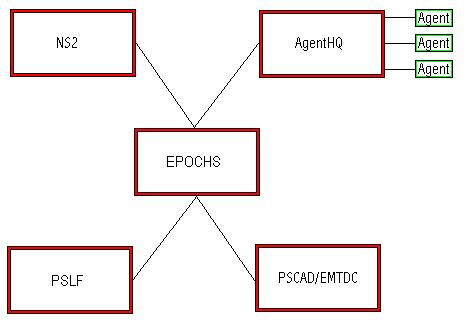
A Sample EPOCHS Application
We have created a small backup relay test system to illustrate how
EPOCHS can be used to investigate power system scenarios. Relays
and breakers together can be thought of as the fuses in your
house. They are supposed to trip to isolate problems when power
anomalies occur. The relay detects abnormal situations and then
instructs breakers to act. Breakers are the devices that actually
trip lines. The goal is to trip breakers so that the smallest
possible problem area is taken out of service until the situation
corrects itself or a repair crew can be disbatched. Power system
equipment is traditionally made up of autonomous units that sense the
environment and make decisions based solely on local readings. We
added communication to backup relays so that each exchanged local
information with their neighbors at regular intervals. In this
type of environment, we can take a large system like the New York Power
Pool, zoom in to a small area like the one used as our example power
system, and still receive a representative sample of how our scheme
behaves making it an ideal first trial for the EPOCHS environment.
We would like to emphasise that EPOCHS is capable of simulating much
larger scenarios if the situation calls for it.
In this case, we have created five buses. The first and last
bus are both connected to a generator. There are four transmission
lines between the first and last bus. Distances listed in
kilometers are here to give a sense of how long transmissions lines are
in realistic scenarios, but they do not have a large effect on the
environment in question as power travels at close to the speed of
light. Each bus has one or more relays connected to it labeled R1
to R8. There are also a series of breakers labeled B1 to B8.
In our scenario, a fault has occured between the bus labeled M and the
bus labeled N. That fault is marked with an X and is labeled with
an F. This fault might be a lightning bolt causing line
disruptions. We are assuming that either a relay or breaker has
failed to act appropriately and that it is the job of the backup relay
to take action to clear the fault.
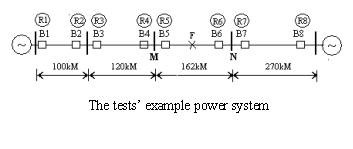
Our backup agents are each equipped with a series of simple rules
that they follow. The rules are designed to detect problems and
determine whether or not the primary relay has responded
appropriately. If it has not and enough time has passed then the
backup relay will take action.
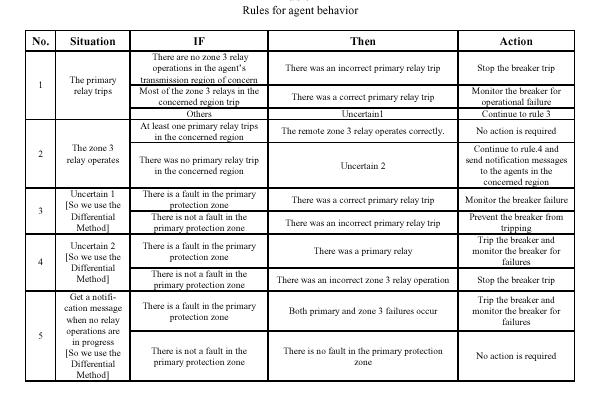
Relays send a message containing their current state with their
neighbors once per time step using a UDP packet.
In this example, the fault in line MN occurs at time 0.3
seconds. The backup relay 5 agent immediately detects the abnormal
situation and then waits to see if the primary relay/breaker combination
will take action. After the breaker clearing time has passed, the
breaker takes action clearing the fault. Backup relay 5 trips and
then sends an immediate trip command to relay 4. Relay 4's
breaker fails to trip and the failure cascades to backup relay 3 which
also trips. This whole sequence of events takes much less time
than would be necessary using a traditional scheme without
communication.
All agent actions took place in user-written modules in the Agent
section of the EPOCHS systems. The agents perceive a unified
environment that is presented to them through read and write requests
made on their behalf by the AgentHQ. Communication takes place
inside NS2 with each relay/breaker location represented as a
communication node. Transmission lines are treated as ethernet
lines. PSCAD/EMTDC serves as the power simulator and all power
state is read/written through the EPOCHS RTI.
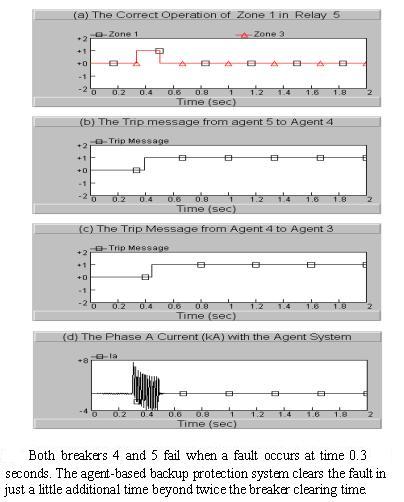
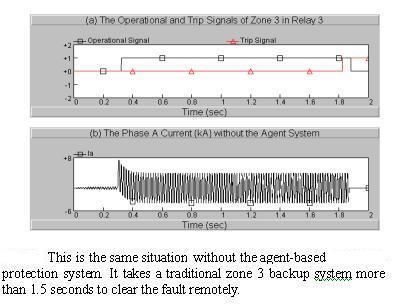
A more detailed description of this scenario can be found under the
EPOCHS Publications section below.
EPOCHS Distribution
You can download the EPOCHS distribution from here.
EPOCHS Publications
The sample application outlined above appeared at a conference in the
Fall 2002. A publication on the EPOCHS infrastructure itself is
currently in preparation.
Wang, X.R.; Hopkinson, K.M.; Thorp,
J.S.; Giovanini, R.; Birman, K.; Coury, D., Developing an Agent-based Backup Protection System for
Transmission Networks. First International Conference on Power
Systems and Communication Systems Infrastructures for the Future. 23-27
of September 2002, Beijing, China.
Page Last Modified
10/30/04